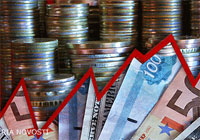Crash Course: The Ruble’s Volatile Two Decades

(RFE/RL – rferl.org – Carl Schreck – December 02, 2014) The Russian ruble’s sharp plunge this week, which saw it fall below 50 to the U.S. dollar, has revived the specter of the kind of currency crisis that Russians have suffered through repeatedly over the past 25 years.
The ruble on December 1 took its steepest dive in intraday trading since 1998, when the Russian government defaulted on domestic debt on August 17 of that year and effectively devalued the ruble fourfold.
Sergei Aleksashenko, a former deputy finance minister under President Boris Yeltsin, says elements of the ruble’s current struggles remind him of that dark chapter in the currency’s turbulent recent history.
“What’s happening now, say in the last days or weeks, reminds me strongly of the 1998 crisis after August 17, when psychology was the driving factor, a lack of faith of citizens and the business community in the national currency and the desire to flee from the ruble in any direction,” Aleksashenko said.
When this mindset “transforms into panic,” he added, “it’s very, very difficult for the central bank to stave off devaluation.”
Monetary mayhem, however, is nothing new for Russia. Here’s snapshot of currency turmoil and devaluation in Russia over the past quarter century.
Soviet Twilight
The Soviet Union’s final years saw the government grappling with a flailing economy and introducing monetary measures that sparked panic in the populace.
In January 1991, Soviet leader Mikhail Gorbachev issued a decree voiding all 50- and 100-ruble notes in a bid to crack down on black-market currency dealers. Soviet citizens were given just three days to trade in their old notes, prompting angry mobs to descend on banks unprepared to handle the scale of the operations.
Later that year, the government slashed the ruble’s value under the “tourist rate” — offered by state banks to foreigners and Soviet citizens traveling abroad — from around 6 rubles to around 27 rubles to the dollar. The ruble continued to tumble for the rest of the year as the dollar increasingly became Russians’ currency of choice. By early December 1991, the ruble was valued at nearly 100 to the dollar. Later in the month, the Soviet Union ceased to exist.
‘Shock Therapy’
The skyrocketing inflation under the Yeltsin government’s free-market “shock therapy” reforms following the Soviet collapse saw millions of Russians lose their savings and the ruble weaken steadily over the course of several years.
In January 1994, the government banned domestic use of the U.S. dollar and other foreign currencies for purchases of goods and services in a bid to halt the ruble’s slide. In October of that year, the ruble plummeted 27 percent in a single day of trading that became known as “Black Tuesday” before the central bank stepped in to prop up the national currency. Before the Russian government lopped off three zeroes from the ruble in January 1998, a single U.S. dollar was worth around 6,000 rubles. Following the move, $1 was worth 6 rubles.
August 1998
After Russia defaulted on its debt and effectively devalued the ruble in August 1998, numerous Russian banks collapsed and ordinary citizens watched their savings vanish. In less than a month, the ruble plunged from 6 to 16 versus the dollar, eventually stabilizing at around 24 rubles to the dollar. Inflation for the year soared to 84 percent, while Russia’s GDP declined by 4.9 percent.
The 1998 crisis spawned a drastic decline in imports to Russia as the ruble weakened, though the devaluation strengthened demand for domestic production seen as crucial in the country’s quick rebound from economic calamity.
Great Recession
After nearly a decade of strong economic growth on the back of lofty oil prices, both Russia’s economy and the ruble were hit hard by the 2008 global economic crisis, in part due to falling energy prices. In early August of that year, the ruble was trading at a high of 23.4 to the dollar but shed 35 percent of its value against the dollar by January 2009.
The Russian government embarked on a policy of “controlled devaluation” to deal with the crisis, using foreign reserves to temper the ruble’s decline. Russian President Vladimir Putin, serving as prime minister at the time, said the policy was aimed at giving Russians the opportunity to “decide what they should do with their savings.”
‘Foreign Policy Adventures’
Aleksashenko,the former deputy finance minister, says that the roots of the ruble’s current struggles lie both in the falling global oil prices and Russia’s actions in the Ukraine crisis, including the annexation of Crimea and ensuing Western sanctions.
Sergei Guriev, a respected Russian economist and a former member of Sberbank’s supervisory board, concurs, adding that stagnant economic reforms and rampant corruption are exacerbating the situation.
“The ruble is the function of two variables: one is oil price, and the other one is capital outflow,” Guriev told RFE/RL. “Oil prices are going down, and this is not something that is homegrown. But capital outflow, and lack of capital inflow is homegrown in the sense that it is a function of foreign policy adventures and sanctions, and also lack of reforms that undermine the belief of the investors in the future of Russian economic growth.”
“If Russia had better policy and better foreign policy,” Guriev added, “the ruble would be stronger.”
Article from Radio Free Europe/Radio Liberty – rferl.org – ©2014 RFE/RL, Inc. Article also appeared at rferl.org/content/ruble-history-crashes-russia-economy/26720846.html
